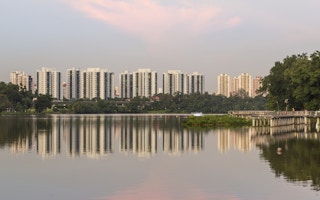As a small country obsessed about its relevance to the wider world, Singapore sets itself big targets as a way to differentiate itself from rivals and remain competitive.
To continue reading, subscribe to Eco‑Business.
There's something for everyone. We offer a range of subscription plans.
- Access our stories and receive our Insights Weekly newsletter with the free EB Member plan.
- Unlock unlimited access to our content and archive with EB Circle.
- Publish your content with EB Premium.
That has, in its short 50-year history, served it well. It is, after all, known as a leading hub in Asia for services such as finance and air transit, and is one of the region’s most economically competitive and liveable cities.
Late last year, in a bid for Singapore to maintain its global edge and to capitalise on a new technological revolution gathering pace across the globe, Prime Minister Lee Hsien Loong launched a new vision for the city-state to be the “world’s leading Smart Nation” where “people live meaningful and fulfilled lives, enabled seamlessly by technology, offering exciting opportunities for all”.
Around the same time, he also unveiled the Sustainable Singapore Blueprint, which outlines a $1.5 billion effort to become an eco-friendly city with a “zero waste” culture and a flourishing green economy by 2030.
The timing was probably a coincidence, but in many ways entirely appropriate, because being a smart and sustainable city are two sides of the same coin.
Singapore’s ability to realise both visions will depend largely on the successful interaction of public- and private-sector efforts across a wide range of regulatory frameworks and industries.
But first, what exactly is a smart nation?
While experts differ on what constitutes a smart city, the general consensus is that a smart city is one that deploys technology to improve urban life.
Advocates say this is done in three main ways: to enhance the quality and performance of infrastructure services such as healthcare; reduce resource consumption and hence costs; and to help governments engage more effectively with their citizens.
Think sensors that observe traffic flow to notify commuters of efficient routes and potential congestion; smartphones that enable citizens to transmit data to government agencies on municipal problems; intelligent systems that reduce energy usage of buildings to a minimum or Internet connectivity that feeds people useful on-the-go information on, say, car-sharing options or the nearest hospital.
This global wave of technological innovation is profoundly changing the way people live and interact with each other - and will continue doing so.
It is no surprise that cities across the rapidly-urbanising world have sought smart city solutions to tackle urban challenges such as pollution, congestion, and overcrowding. Given rising global concerns on climate change, the urgent need to reduce carbon emissions and the need to build resilience within city infrastructure to face extreme weather events and disasters, smart cities are seen as urban utopias promising to deliver better lives for all and, ultimately, make cities more sustainable.
Just hype?
The future is not all rosy, however. Detractors warn that smart cities might just be hype - a path towards further inequality, data insecurity and loss of privacy for citizens.
The widespread use of technology can exacerbate the divide between the haves and have nots. In developing cities that lack institutions and structures of good governance, the rise of the smart city may also worsen issues such as poor income distribution and lack of equal opportunity.
In China, for example, where the government has included smart cities as a key feature of its urban ambitions, there is also growing concern about the surveillance culture in which citizens will be eventually tracked in cities packed with sensors, cameras and drones capturing their every movement. Some critics such as British author Steven Poole calls the smart city “a place like Rio on steroids, where you can never disappear”.
Others like Adam Greenfield at LSE Cities, author of the 2013 book, Against The Smart City, lambasts the concept as being conjured up by big IT multinationals to boost profits, allowing faceless machines - not the people - to decide how a city will function.
Getting it right
So how do Singapore’s smart city ambitions stack up against these concerns? Pretty good - so far.
Government officials are using sustainability in the language surrounding Singapore’s smart city initiatives and this is being turned into pilot projects on the ground.
The Infocomm Development Authority (IDA) has identified sustainability as one of nine key themes in its Infocomm Technology Roadmap.
At Jurong Lake District, for example, where most of Singapore’s cutting-edge smart city solutions are being tested, over 1,000 data sensors are being deployed in sustainability, urban mobility, and improving sensing and situational awareness.
One pilot project is uClim, a Web-based service that gives planners access to real-time environmental information such as temperature, relative humidity and air quality to enable them to monitor, quantify, and visualise microclimates.
“
Ultimately, a smart nation is not about technology; it is about applying technology to enhance quality of life for citizens, improve economic opportunities and strengthen community cohesion.
There is also the IoT@Home initiative, which is working with the private sector to establish open standards and open architecture to support better inter-operability between devices, so as to allow the development of Internet of Things applications for homes in the areas of wellness, home-based care, actve ageing and sustainable living.
To address cyber security and help keep data and networks secure, a new government outfit - the Cyber Security Agency of Singapore - was launched in April. On data privacy, the IDA has also stressed that it is working to be compliant with Singapore’s data-protection legislation, which provides a comprehensive legal framework in this regard.
The IDA also has a separate scheme that addresses the digital divide by subsidising Internet and telephone connections, as well as tablet devices for low-income families. Public agencies such as the Ministry of Finance have also set up free public booths for citizens to access government online services.
The fact that Minister for the Environment and Water Resources Vivian Balakrishnan - who heads the lead ministry for the Sustainable Singapore Blueprint - is also in charge of the Smart Nation initiative, is an arrangement that will help ensure that Singapore’s smart nation push is one that puts sustainability at its core.
Speaking at the inaugural Smarter Cities Roundtable held by Swiss technology giant ABB and Eco-Business last week, Dr Balakrishnan noted that “a sustainable environment, a dynamic economy and a Smart Nation are really three dimensions of a tightly interconnected nexus”.
If Singapore gets it right, it will help address some of the biggest challenges confronting the world now, such as climate change, painful economic restructuring, and achieving greater cohesion amid growing fundamentalism and terrorism, he said.
At the dialogue, attended by 40 senior business, government and civic society leaders, which I moderated, participants all agreed that in the years to come, sustainability - and people - should guide the development of Singapore’s smart city projects.
Ultimately, a smart nation is not about technology; it is about applying technology to enhance quality of life for citizens, improve economic opportunities and strengthen community cohesion.
For this to work, Singapore’s smart nation efforts should not just entail top-down policymaking, but also driven by bottom-up, community-led initiatives.
Examples of these include crowd-sourcing technologies and apps that enhance community living or that enable people to share or rent out their underused assets.
The Government has largely been supportive of this by encouraging a dynamic entrepreneurial system here, in which smart city ideas and innovations are given the opportunity to flourish.
More importantly, the progress of these smart and sustainable initiatives should be measured and tracked against pre-determined indicators to ensure that they are on the right track.
For example, are these programmes truly helping to reduce energy consumption? Or are they adding to wasteful demand for more data servers? Is the commuting experience improving for citizens from year to year? Are second-hand and sharing economy technologies contributing to increased national recycling rates?
By putting sustainability before smart, Singapore will stand a better chance of realising its grand ambition in a meaningful way.











